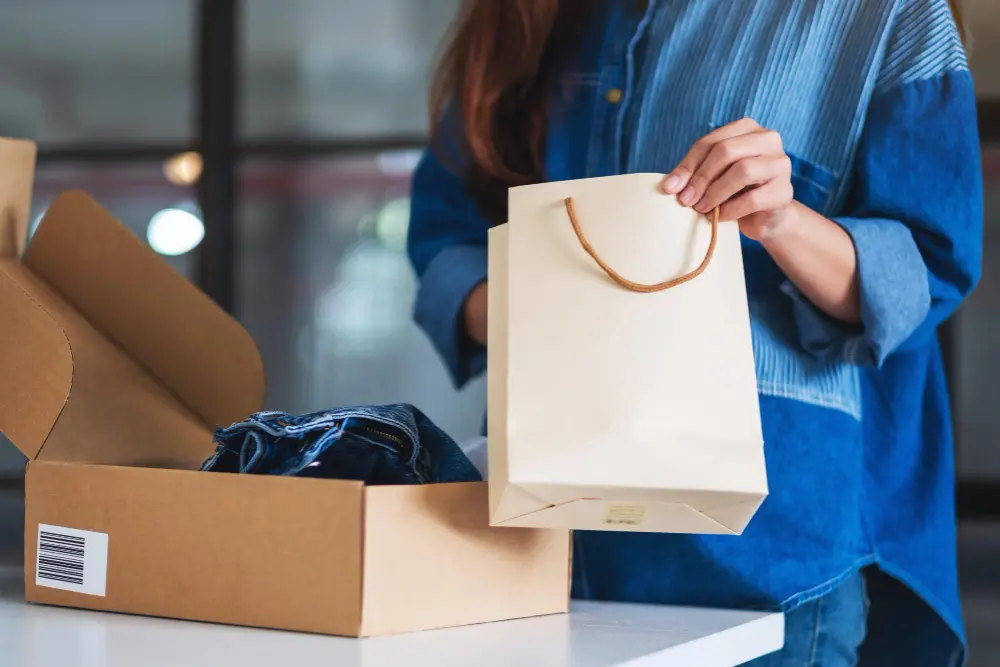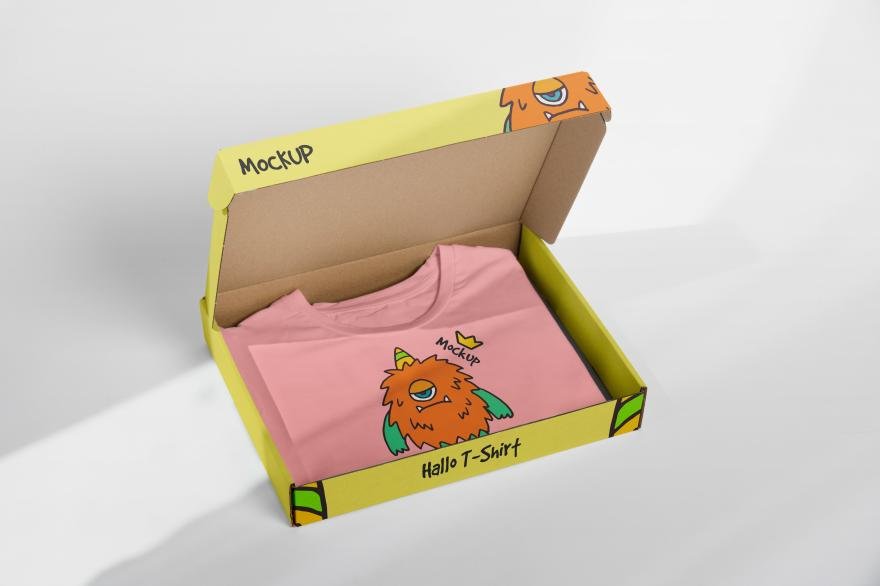Struggling to design apparel packaging for both online and in-store sales? It is confusing. Using the wrong approach for a channel can hurt your brand and your bottom line.
The main difference is purpose. E-commerce packaging must be durable for shipping and create a memorable unboxing experience at home. Retail packaging focuses on grabbing attention on a crowded shelf and providing an easy carry-out solution. Each needs a totally different design strategy.

I've been in the packaging business for over 16 years. During that time, I've seen brands try a one-size-fits-all approach to packaging, and it almost never works. An e-commerce box looks out of place in a boutique, and a retail bag won't survive a trip through the mail. You need to design for the specific environment. Let's break down the key differences to help you create packaging that performs perfectly, no matter where your customers are buying.
How does the primary role of packaging change from shelf to shipment?
Worried your beautiful apparel will arrive damaged? E-commerce shipping is a rough journey. A simple retail box just won't cut it for the trip from a warehouse to a customer's doorstep.
The role changes from attraction to protection. Retail packaging is a salesperson on a shelf, designed for visual appeal and to be carried home. E-commerce packaging is a shipping container, built to withstand drops, impacts, and bad weather while protecting the product inside until it's opened.

I remember a client who came to me after receiving dozens of complaints. They were using their standard retail gift boxes for online orders. The boxes were beautiful but thin. By the time they reached customers, they were crushed and torn. The products inside were fine, but the customer's first impression was a disaster. We had to redesign their mailers completely. This shows just how different the demands are.
The Retail Shelf Environment
In a retail store, the package's main job is to stand out. It competes with dozens of other brands right next to it. The structure needs to be good enough to stack on a shelf and be handled by customers, but it doesn't need to be a fortress. Security is also different. It's more about preventing in-store theft with tags or sealed flaps than surviving a long journey.
The E-commerce Gauntlet
E-commerce packaging goes through what I call "the gauntlet." It gets tossed into bins, rides on conveyor belts, is stacked in trucks, and is handled by multiple couriers. It must protect the apparel from being bent, snagged, or exposed to moisture. The structure needs to be much more robust.
Here's a simple breakdown:
| Feature | Retail Packaging | E-commerce Packaging |
|---|---|---|
| Primary Goal | In-store attraction, brand visibility | Protection during transit |
| Material Strength | Moderate, optimized for looks | High, optimized for durability |
| Security Focus | Anti-theft in the store | Tamper-evident seals for shipping |
| Handling | By store staff and customers | By logistics workers and machines |
Why is the unboxing experience so critical for e-commerce brands?
Is your online packaging just a boring brown box? You're missing a key marketing opportunity. That first physical interaction is where you build a real connection with your customer.
For e-commerce, the packaging is the storefront. The unboxing experience is the moment the customer physically meets your brand. A great unboxing is a shareable moment that builds loyalty. In retail, the experience is the store itself, and the packaging is just a functional takeaway item.

We worked with a new online clothing brand that was putting their shirts in plain poly mailers. Sales were okay, but they had zero social media buzz. I suggested we design a custom-printed mailer box with branded tissue paper and a small "thank you" card inside. It cost a bit more per unit, but the impact was huge. Within a month, customers started posting unboxing videos on TikTok and Instagram. The packaging became a real marketing asset for them.
Your Brand's First Hello
When a customer shops online, they click buttons on a screen. The delivery of the package is the first time they physically interact with your brand. This "first hello" can make or break their perception. A plain box with a product tossed inside feels transactional and cheap. A carefully designed box with layers to unwrap feels like a special gift. It tells the customer you care about the details, which suggests your product is high-quality too.
Designing the "Wow" Moment
Creating a great unboxing experience is about building anticipation. Think in layers.
- The Outer Mailer: This is your billboard. It should be branded and durable.
- The Inner Presentation: When the mailer is opened, what's the first thing they see? Branded tissue paper, a sticker seal, or a custom-fit product box all elevate the experience.
- The Reveal: The apparel itself should be neatly folded and presented.
- The Extras: Inserts like a thank you note, a return guide, or a small gift add a personal touch.
In retail, the customer gets this "wow" moment from the store's lighting, music, and service. For e-commerce, it all has to happen in the box.
How do logistics and costs shape packaging decisions differently?
Are high shipping fees eating into your profits? The size and weight of your e-commerce package directly impact your bottom line. A design that is cost-effective for retail can be a financial disaster online.
E-commerce costs are driven by dimensional (DIM) weight and the need for durable materials, pushing for lightweight, compact designs. Retail costs focus on getting the most units on a pallet and keeping material costs low for visual impact, not heavy-duty protection.

I often have to explain dimensional weight to new e-commerce clients. One wanted to use a big, impressive box for a single t-shirt. It looked great, but the shipping cost was triple the cost of the shirt itself because the box was mostly empty air. We switched to a flexible mailer with a rigid insert. It still looked premium but cut their shipping costs by 70%. For designers, understanding these logistics is just as important as the graphics.
The Challenge of Dimensional Weight
Shipping carriers like FedEx and UPS charge for the space a package takes up in their truck, not just its actual weight. This is called DIM weight. To calculate it, they multiply the length, width, and height of a box and divide by a special number (the DIM factor). If the DIM weight is higher than the actual weight, you pay for the higher number. So, for e-commerce, every inch of empty space in your box costs you money. Smart design means making the package as small and lightweight as possible while still being protective.
Retail's Focus on Shelf Efficiency
In retail, the big logistical cost is shipping products from a central warehouse to hundreds of stores. Here, the goal is pallet optimization. You want to fit as many units as possible onto a single pallet to reduce freight costs. The shape and size of the retail box are designed for efficient stacking. Another major factor is reverse logistics. E-commerce packaging must often be easy for customers to use for returns, which means it should be resealable or easy to repack. This is rarely a consideration for retail packaging.
| Cost Factor | E-commerce Focus | Retail Focus |
|---|---|---|
| Primary Driver | Shipping cost per unit (DIM weight) | Bulk freight cost (pallet efficiency) |
| Material Choice | Lightweight yet strong materials | Visually appealing but cost-effective |
| Returns | Package must be easy to reuse/repack | Not a primary design concern |
| Labor | Designed for fast order fulfillment | Designed for easy shelf stocking |
Conclusion
In short, e-commerce and retail apparel packaging serve different goals. One is for a hard journey and a personal reveal; the other is for a crowded shelf and instant appeal.






